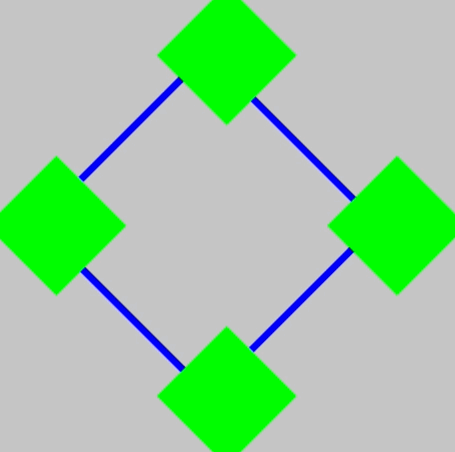Create a free profile to get unlimited access to exclusive videos, sweepstakes, and more!
Optical Illusion: Are These Lines Moving, or Is This a Spinning Square?

Our brains are a mess.
They evolved step by step, one function added to another in a million small steps that might help in one way, but that conflict with what another part of the brain is trying to do. When you couple that with the fact that our senses bombard our brains with signals, flooding them with input, our ability to make sense of any of the world at all is nothing short of astonishing.
But it doesn’t always work with optimal efficiency, leading to confusion, and sometimes short-circuiting our perception.
That’s why optical illusions are so wonderful. They lay bare these miscues, allowing us to perceive them and understand them.
Here’s a great example of this: Watch this looping animated GIF (adapted from a demo by Michael Bach). You’ll see two sets of parallel lines moving in perpendicular directions … until the green squares pop up.
Do you see the illusion? At first, the two sets of lines appear to move independently of each other, moving back and forth at a 45° angle, perpendicular to the motion of the other set of lines. When I watch, my brain has no trouble separating them.
But then those squares pop up, and suddenly the four lines are all moving in sync, appearing like the attached sides of a square moving in a circular motion! The illusion is very strong.
This illusion is due to “motion binding.” This is where you see two or more sets of objects moving, and our brains let the motion of one set influence how we perceive the motion of the other. We see the two motions bound together, even if they aren’t.
It’s not a problem when the lines are separate. Those gaps are important, because it’s a clue to our brains that the two sets of lines are indeed different. But cover up the corners, and that piece of information is lost. The brain tries to link them together, and the motion suddenly becomes coherent as a whole.
I’ve seen lots of discussion about this online, but no one points out an important part: the lines themselves. Each line is a single, solid color. That doesn’t matter when the corners are not covered; the lines are moving in and out. But when the corners are covered, our brains interpret the motion as not just in and out, but also side to side a bit, sliding along their own length. But that motion is an illusion. It’s not real. It’s only the green squares covering up the gaps that makes it seem like the lines are sliding.
If the lines were not a solid color, but instead broken up into black and white squares along their lengths, that would be another clue to their motion, and the illusion would vanish, or at least be much harder to sustain (for more about this, read the demonstration on the right column of page 185 of this book).
I find this fascinating, and really engaging to play with. What happens if instead of looking over the whole picture, you instead concentrate on the motion of a single side of the “square”? If I do that, I can see the individual motions again, even when the green squares appear. But my grasp is tenuous, and if I lose my concentration suddenly, it’s a gyrating square again.
Amazing. And a very important lesson: What you see in the world may not be what’s really happening. Our eyes and brains are very, very easy to fool. We see patterns where none exist, no patterns where they do, motions when there are none, and more.
Seeing is not believing. Or at least it shouldn’t be. Remember that when someone reports a UFO, or a ghost, and says, “I know what I saw!” Because I’d be willing to bet they really don’t.
I love illusions, and how they show us not to necessarily trust our senses. Here are some examples that will hurt your brain.
- This Illusion Will Drive You Mad
- Another Mind-Crushing Illusion: Straight or Curved Motion?
- The Dragon That Follows Your Gaze
- Rotating Rings
- Viral Illusion Will—and Should—Have You Doubting Your Eyes
- The Blue and the Green (my most favoritist ever)
- Aural Illusion (because you’re ears can be fooled too)
Tip o’ the Necker cube to @nidavellir and to Slate video team member Shon Areih-Lerer for creating that animated GIF.


























